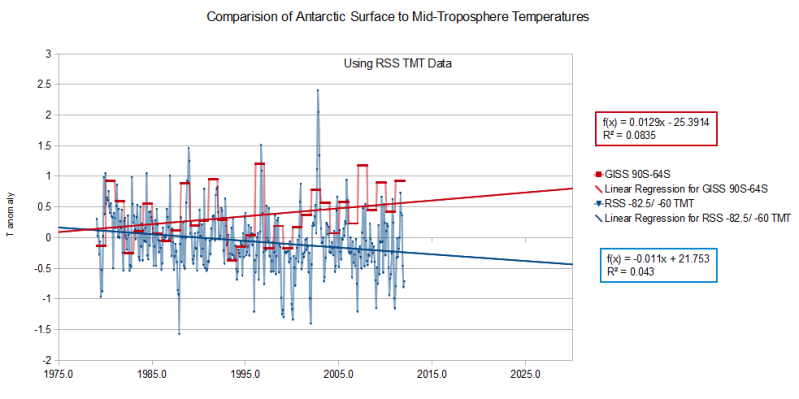New Computer Fund
Saturday, March 3, 2012
Thermohalide Cycles and Antarctica
The impact of Antarctica on the thermohaline circulation of the oceans has been plauging me for some time. Most of the problem is the lack of quality data in the Antarctic and the length of the instrumental temperature record. The chart above appears to be a key part of that puzzle. By using the RSS Antarctic region mid-troposphere temperature data, I appear to have found a conflict with the surface temperature average. The Antarctic according to RSS is cooling and has been cooling for some time.
This reconstruction of temperatures in southern South America, from the NOAA paleo website, provided by R. Neukom1, J. Luterbacher2, R. Villalba3, M. Küttel1,4, D. Frank5, P.D. Jones, M. Grosjean1, H. Wanner1, J.-C. Aravena7, D.E. Black8, D.A. Christie9, R. D'Arrigo10, A. Lara9,11, M. Morales3, C. Soliz-Gamboa12, A. Srur3, R. Urrutia9, and L. von Gunten1,13., may indicate that current cooling in the Antarctic started around 1945, hard to tell. There appears to be general cooling for the entire length of the reconstruction with general warming for the last half.
Since I suspect some influence from the 22 year Hale solar cycle, the above plot compares the SSA reconstruction with the Jacoby et. al Taymyr Peninsular reconstruction from Siberia. This shows that both have similar longer term pseudo cycles and there is roughly a 30 year lag between the two polar regions. There is also a change in the correlation starting around 1931. This change is likely due to agricultural and/or industrial expansion in the northern hemisphere which did not occur to the same extent in the southern high latitudes.
Nearly lost in all the noise is the lag between the two polar regions. Since radiant forcing is much more rapid than ocean heat uptake or loss, the Antarctic is a major source of the deep ocean heat loss and that there appears to be little change in the Antarctic due to the efforts of mankind, I would suspect that the lag is related to ocean heat content. That suspicion may be a reach, but the cycle length of the Pacific Decadal Oscillation agrees rather well with the lag.
The physical cause of the lag is somewhat complex. If it were in better agreement with the solar cycle, it would have already been well documented. Since it has not been well documented, it is open to theory.
The best explanation I can find for the lag and the long term pseudo oscillation is the change in atmospheric conduction caused by Carbon Dioxide variation associated with general warming and cooling combined with the tropopause altitude/temperature variation cause by the radiant forcing variations of the same greenhouse gases.
In order to warm the surface, the greenhouse gases must cool the tropopause. Since the Antarctic is closely related to the conditions of the tropopause, that cooling, out of phase with surface warming, increases deep ocean heat loss in the Antarctic region waters.
With the apparent error in the Antarctic surface station data, this unique feedback relationship would not be obvious. Also because of limited instrumentation, the relationship of the Antarctic geomagnetic north pole and synchronization with the solar magnetic field impacting the efficiency of ocean heat loss to the Antarctic atmosphere, is not easily verified.
Time though will resolve all of the issues. In the mean time, simple options to avoid excessive Northern Hemisphere warming are available.
http://tenaya.ucsd.edu/~tdas/data/review_iitkgp/2010JD013949.pdf
The average length of the thermohaline cycle appears to be 236 years, BTW. Much better paleo reconstructions would be needed to confirm that, but focusing a little more on regional reconstruction should help resolve that issue. I believe that a newly launched polar orbital satellite should make some head way on the geomagnetic issue. In any case, that is the new installment in my theory of the ice ages.
Subscribe to:
Post Comments (Atom)



No comments:
Post a Comment